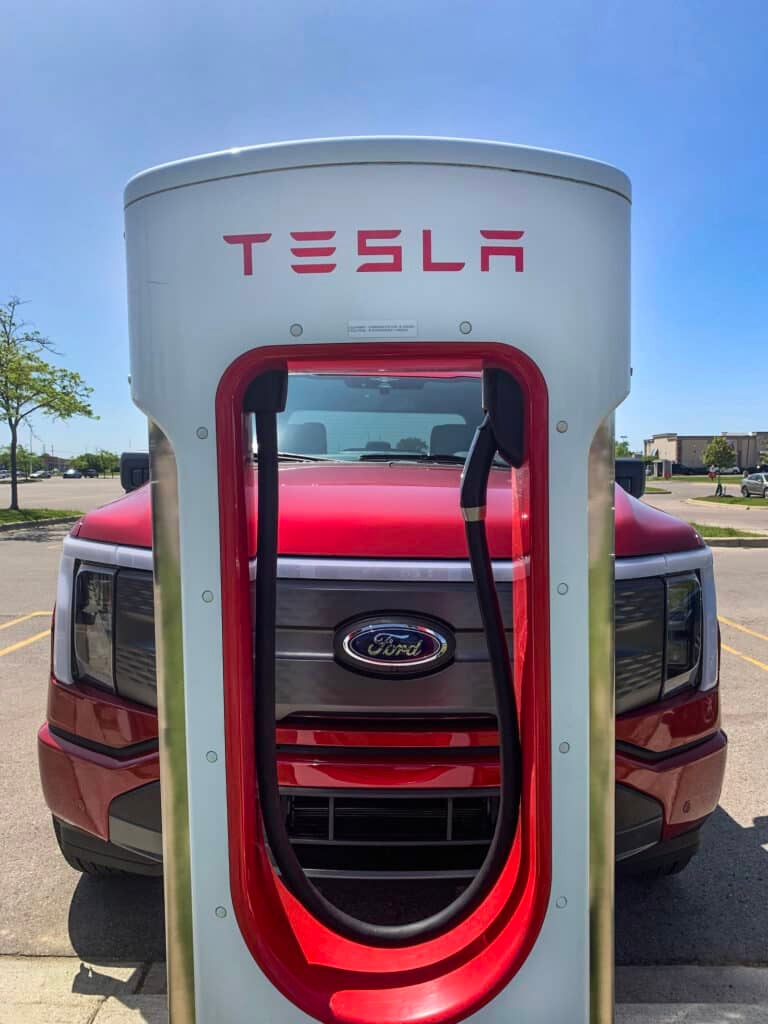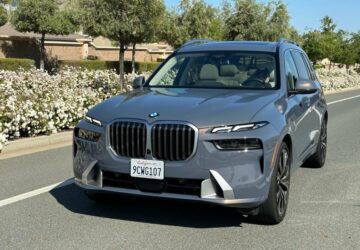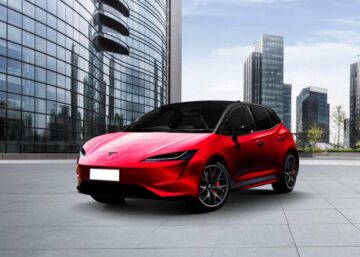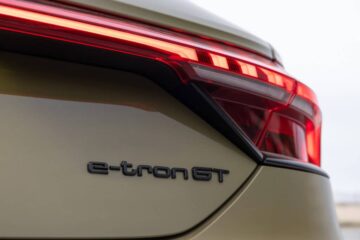Ford slashed the price of its popular F-150 Lightning battery-electric vehicle on Monday, reflecting increasing pressure on manufacturers to align with the cuts EV segment leader Tesla has made since the beginning of the year.

Various versions of the electric pickup will drop in price by as much as around $10,000. The move marks an about-face for the second-largest Detroit automaker as Ford previously raised the cost of the Lightning several times since it went on sale in spring 2022.
The automaker credited the cuts to “greater plant capacity (and) improving efficiencies,” but analysts said Ford faced growing pressure as Tesla and others have tried to bring EV prices more in line with comparable gas-powered products. It has also helped that the cost of the raw materials used in EV batteries has started coming down after spiking sharply in 2022.
Working to “improve accessibility and affordability”
“Shortly after launching the F-150 Lightning, rapidly rising material costs, supply constraints and other factors drove up the cost of the EV truck for Ford and our customers,” said Marin Gjaja, chief customer officer, Ford Model e, the automaker’s electric vehicle arm.

“We’ve continued to work in the background to improve accessibility and affordability to help to lower prices for our customers and shorten the wait times for their new F-150 Lightning,” Gjaja added.
Up to $10,000 in price cuts
Buyers purchasing low-end versions of the Lightning will benefit most from Monday’s move. The standard-range Pro package, now will go for $49,995, a $9,979 discount from its prior price of $59,974.
The top-end model, the long-range F-150 Lightning Platinum, will receive a $6,079 cut. It previously was going for $98,074 but will now be priced at $91,995.
Conflicting pressures

Automakers like Ford have faced conflicting pressures as they ramp up production of battery-electric vehicles. They’re investing tens of billions of dollars to increase capacity, with little to no short-term payoffs expected, Tesla being the only manufacturers currently selling EVs at a profit.
In Ford’s case, it initially set up a manufacturing facility in Dearborn, Michigan alongside one of its conventional F-150 plants. It tooled up with a capacity to roll out just 25,000 Lightnings annually. But a huge surge in demand following the truck’s launch forced the automaker to retool, with a goal of reaching an annualized production run rate of 150,000 by the end of 2023, said Darren Palmer, Ford’s global director of battery-electric vehicle product development.
Demand for EVs in general has automakers examining their output levels, with Ford earlier this year announcing plans to expand production capacity for its other retail EV, the Mustang Mach-E.
Compounding the problem, raw material costs ballooned in 2022 as more automakers got into the EV game and concerns mounted that there weren’t enough supplies of materials like lithium, cobalt, manganese and nickel. Through mid-2020, raw lithium carbonate was hovering around $50,000 a ton. It peaked at just under $600,000 last November. The cost has dropped 35% so far this year but still has been running just over $300,000 in recent weeks.

Consumer pushback
But automakers also have to cope with pressures from the consumer market. While a growing number of U.S. motorists say they are considering going electric, according to studies by J.D. Power and others, there’s been pushback over pricing. The typical EV now costs $5,000 to $10,000 more than a comparable vehicle using an internal combustion engine, based on industry data.
Then there’s the emerging market segment’s 800-pound gorilla. After raising prices several times in recent years, Tesla reversed course late last year. It began with a modest price cut in the final weeks of 2022 aimed at helping it meet its annual sales targets. Tesla followed with new cuts in January and has announced still more since then.
Further exacerbating the problem, the new Inflation Reduction Act effectively eliminated the $7,500 federal incentives on most EVs – though many manufacturers have begun using a leasing loophole to restore that giveback.
Ford EV sales take an unexpected dip
Ford previously cut prices on its Mustang Mach-E and, many analysts forecast, it was only a matter of time until it followed up with reductions on the Lightning after it showed some unexpected weakness in sales the last several months. Ford’s EV sales dipped 2.8% during the second quarter, even though the overall market for electric vehicles has risen about 50% so far this year.
Like many rivals, Ford has been lining up new suppliers for raw materials, notably lithium. It will need a steady source as it heads towards a target of selling 2 million EVs annually worldwide by 2026.
- SEO Powered Content & PR Distribution. Get Amplified Today.
- PlatoData.Network Vertical Generative Ai. Empower Yourself. Access Here.
- PlatoAiStream. Web3 Intelligence. Knowledge Amplified. Access Here.
- PlatoESG. Automotive / EVs, Carbon, CleanTech, Energy, Environment, Solar, Waste Management. Access Here.
- BlockOffsets. Modernizing Environmental Offset Ownership. Access Here.
- Source: https://www.thedetroitbureau.com/2023/07/ford-bows-to-pressure-slashes-price-of-f-150-lightning-pickup/
- :has
- :is
- $UP
- 000
- 2022
- 2023
- 2026
- 25
- 35%
- 500
- a
- About
- accessibility
- According
- Act
- added
- After
- aimed
- align
- allowed
- alongside
- also
- an
- Analysts
- and
- announced
- Announcing
- annual
- annualized
- Annually
- Another
- ARE
- ARM
- around
- AS
- At
- automakers
- background
- based
- batteries
- BE
- been
- began
- Beginning
- begun
- being
- benefit
- billions
- body
- bring
- Bureau
- but
- by
- Capacity
- case
- charging
- chassis
- chief
- coming
- company
- comparable
- Concerns
- Conflicting
- considering
- constraints
- consumer
- continued
- conventional
- Cost
- Costs
- course
- Currently
- customer
- Customers
- Cut
- cuts
- Darren
- data
- decision
- Demand
- Development
- Director
- Discount
- dollars
- down
- Drop
- dropped
- during
- e
- Earlier
- effectively
- efficiencies
- Electric
- electric vehicle
- electric vehicles
- eliminated
- emerging
- emerging market
- end
- Engine
- enough
- EV
- EV batteries
- Even
- Examining
- Expand
- expected
- faced
- Facility
- factors
- far
- Federal
- final
- followed
- following
- For
- forced
- Ford
- Forecast
- from
- front
- game
- General
- Global
- Go
- goal
- going
- Growing
- Have
- heads
- help
- helped
- helping
- HOT
- HTTPS
- huge
- implemented
- improve
- improved
- improvements
- improving
- in
- Incentives
- Increase
- increasing
- industry
- inflation
- initially
- internal
- into
- investing
- IT
- ITS
- J.D. Power
- January
- jpg
- just
- Last
- Last Year
- Late
- launch
- launching
- leader
- leasing
- levels
- lightning
- like
- Line
- lining
- lithium
- little
- loophole
- lower
- Manufacturers
- manufacturing
- many
- Market
- material
- materials
- Matter
- max-width
- Meet
- Michigan
- million
- model
- modest
- Monday
- months
- more
- most
- Mountain
- move
- much
- Need
- New
- Nickel
- no
- Norway
- notably
- note
- November
- now
- number
- of
- Officer
- officials
- on
- ONE
- only
- Other
- Others
- our
- out
- output
- over
- overall
- package
- peaked
- percentage
- perhaps
- Pickup
- plans
- plants
- platinum
- plato
- Plato Data Intelligence
- PlatoData
- Popular
- power
- pressure
- pressures
- previously
- price
- Prices
- pricing
- Prior
- Pro
- Problem
- Product
- product development
- Production
- Products
- Profit
- purchasing
- Quarter
- raised
- raising
- Ramp
- rapidly
- Rate
- Raw
- reaching
- reason
- receive
- recent
- reduction
- reductions
- restore
- retail
- Risen
- rising
- rivals
- Roll
- Run
- running
- s
- Said
- sale
- sales
- say
- says
- Second
- second quarter
- second-largest
- segment
- Selling
- set
- several
- short-term
- showed
- since
- So
- so Far
- some
- Source
- spring
- started
- steady
- Still
- studies
- suggest
- suppliers
- supply
- surge
- Take
- Target
- targets
- tens
- Tesla
- than
- that
- The
- their
- then
- There.
- they
- this
- this year
- though?
- Through
- time
- times
- to
- Ton
- towards
- tried
- truck
- typical
- u.s.
- under
- Unexpected
- until
- used
- using
- vehicle
- Vehicles
- versions
- wait
- was
- weakness
- Weeks
- went
- were
- while
- will
- with
- Work
- worldwide
- year
- years
- zephyrnet











